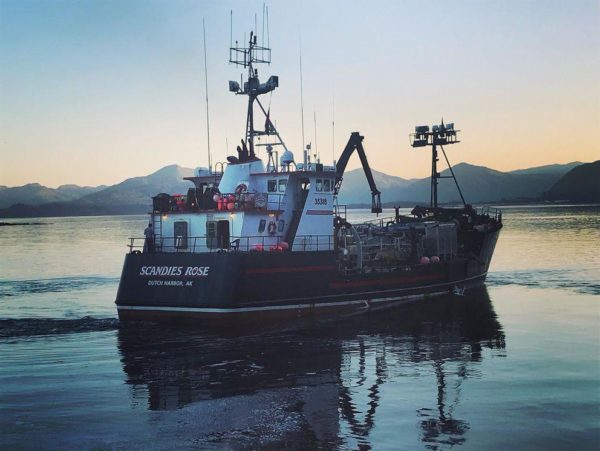
When the Scandies Rose sank on New Year’s Eve of 2019, fishermen from all over Alaska were shocked. Five of the crew perished when the ship rolled onto its side, along with the ship’s captain Gary Cobban. Two crewmembers were rescued from a life raft by a Coast Guard helicopter crew. Captain Cobban was seen as an expert who had been on fishing boats since his teens, and his boat was regarded by many as one of the most modern and well-maintained in the fleet.
This week, the Coast Guard convened a Marine Board investigation into the cause of the sinking. So far, expert witnesses have described serious problems with the boat’s stability report, which is a rating of how stable the vessel is and how much equipment it can bear. And those issues might extend to many other fishing boats around Alaska.
There may have been serious problems with the Scandies Rose’s stability report in particular, and the calculation of how much ice forms from freezing spray, that contributed to an inaccurate estimate of how many crab pots the boat could safely carry.
KMXT’s Dylan Simard has been following the hearing and spoke about it with Alaska Public Media’s Casey Grove.
LISTEN HERE:
This transcript has been edited for clarity.
Dylan Simard: I suppose the most outstanding issue that’s come to light has been the equations marine architects use to make stability reports for the vessels, which are these functional report cards that tell you how safe the boat is relative to how much weight it can bear — how much equipment, how much crab pots. What kind of seas it can interact with safely, and how much ice it can bear before it has a serious weight problem.
The main problem stems from the way the weight of the ice is calculated. When a crab pot boat is moving along, there’s spray coming up from the sea. I’ve heard it described by one retired mariner as if, like magic, it instantly freezes on the mesh and steel frame structures of these crab pots. Over time, this ice builds up and it creates a lot of weight.
But there’s a problem with the way this weight has been calculated. Right now, the way weights are calculated for stability reports, is they take the long sides of the crab pot stack, which is all the pots together on the deck of the boat, and they just assume that ice is freezing on there, as well as maybe on the front and back sides, depending on whether or not they have any sort of shielding on them.
Now, the problem with this is that [pots are] three dimensional — it’s freezing all over these crab pots. So what they’re doing is they’re taking a surface area calculation of the amount of ice, when they should be doing a volume-based calculation.
This is compounded by the fact that there isn’t actually much information on how much these pots weigh. Some engineers have estimated it’s around 300 pounds. But there was one study that was commissioned by the board on the Polar Star, the Coast Guard heavy icebreaker that just went up to the Arctic. They ultimately found that over 2000 pounds of ice had accumulated on this crab pot, which is a lot more than the estimate of 300 pounds.
Casey Grove: That equation, that tells the captain and tells a company that owns the boat, how much they can load onto it, that might be flawed for a lot of other boats, it sounds like.
DS: I mean, if the math is wrong, it’s no telling how far this could extend. Now, plainly, sinkings are quite rare. This doesn’t mean boats are in a state of constant peril. But it could imply the safe bearing weights of these boats could actually be less than what’s currently being calculated.
CG: So, there may be some broad issues there — but it sounds like there might be some really specific problems specific to the Scandies Rose that have been identified as well, right?
DS: That is true. So, as of the testimony from today, the Coast Guard called on a witness. He was assigned the task of creating one of these stability reports for the Scandies Rose, and then comparing that stability report to the existing one the Scandies Rose’s captain would have had.
Now, there are a series of fairly remarkable differences between these reports. The Scandies Rose’s reports didn’t actually have down-flooding ports. These boats are powered by combustion engines, right? They have exhaust, and the exhaust port evidently is something that water could get in, and then get into the engine room. Which would cause a serious problem.
Now, in order for something like this to happen, you’d have to tilt the boat fairly substantially on its side — but if you have a stability report that doesn’t include the existence of these down-flooding ports, you could in theory, pretty seriously overestimate the amount of weight it can bear on one side, the amount of list it can have, before you’re in serious trouble.
CG: Maybe it’s too early to say, but has anybody, either testifying in the hearing or the mariners that you’ve spoken to, commented on what this might mean in the future for other crab boats?
DS: It’s fairly speculatory as of yet, but some of the naval architects who gave testimony for this said there absolutely should be investigation on the part of the Coast Guard particular to crab pots and how they would accumulate ice weight over time. So that when they ultimately make these stability reports, they can have accurate information.
And to further that goal actually, that is why the marine board commissioned that most recent, earlier mentioned experiment on the deck of the Polar Star — to try to make some determination. And that was specific to this hearing.
Casey Grove is host of Alaska News Nightly, a general assignment reporter and an editor at Alaska Public Media. Reach him at cgrove@alaskapublic.org. Read more about Casey here.





